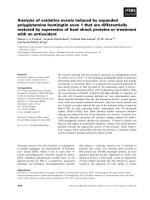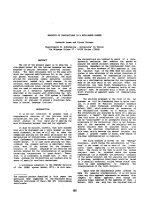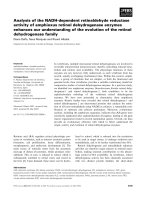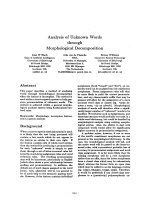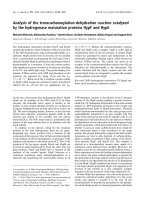báo cáo khoa học: "Analysis of the recurrence risk factors for the patients with hepatocellular carcinoma meeting University of California San Francisco criteria after curative hepatectomy" pot
Bạn đang xem bản rút gọn của tài liệu. Xem và tải ngay bản đầy đủ của tài liệu tại đây (295.01 KB, 6 trang )
RESEARCH Open Access
Analysis of the recurrence risk factors for the
patients with hepatocellular carcinoma meeting
University of California San Francisco criteria
after curative hepatectomy
Ruey-Shyang Soong, Ming-Chin Yu, Kun-Ming Chan, Hong-Shiue Chou, Ting-Jung Wu, Chen-Fang Lee,
Tsung-Han Wu, Wei-Chen Lee
*
Introduction
Hepatocellular carcinoma (HCC) is one of the most
common cancers worldwide, especially in the Asia paci-
fic area [1]. Liver transplantation is theoretically the best
option because it cures both the tumor and the underly-
ing liver disease. The overall survival rate at 5 years
after liver transplantation was around 70-75% [2]. In
contrast, 5-year survival rates after liver resection were
only 40% to 65%, and the 10-year survival rate was 29%.
The high incidence of HCC recurrence following liver
resection is a serious issue. The recurrent rate is as high
as 50-6 0% at 3 years and 70-100% at 5 years. This high
recurrent rate precludes long-term tumor-free survival
of the patients with liver resection for HCC. However,
liver transplantation is limited by a shortage of graft
availability. Liver transplantation also has high perio-
perative risk, and long-term problems such as graft
rejection and infections[3]. Therefore, liver resection is
still the primary selection treatment for many HCC
patients, especially in areas lacking deceased liver.
Nevertheless, there is no doubt that for HCC, liver
transplantation is a superior treatment option to liver
resection, where long-term tumor-free survival is con-
cerned. Adult-to-adult living donor liver transplantation
is a well-established technique now. Liver transplanta-
tion for patients with HCC becomes feasible if a living
donor wishes to donate part of the liver to save a mem-
ber of the family. To optimize the benefit of living
donor liver transplantation for HCC patients, the
question of how to select the right patients to have liver
transplantation is very important.
This study aims to identify the patients who accepted
hepatectomyforatumor/tumors and were within
University of California San Francisco (UCSF) cr iteria[4],
but had a poor 5-year disease-free survival rate (DFS). We
analyze the pre-operative data of the patients and attempt
to find the pre-operative risk factors of HCC recurrence.
These risk factors could be indicators for cli nical doctors
to define and identify the patients with a high risk of
tumor recurrence and to arrange liver transplantation
rather than hepatectomy as the first treatment option.
Materials and methods
Patients
A total of 1595 patients underwent hepatectomy for HCC
from 1983 to 2005 in Chang Gung Medical hospital, Tai-
pei, for whom data were collected. The patient selection
criteria in this study were (1) tumor number and size
within UCSF criteria, (2) no major vessel invasion, (3) no
distal metastasis, and (4) age < 70 years old (based on the
upper limited age of liver transplantation in HCC in this
institute). Totally, 840 cases matching the criteria were the
object of this study. Hospital mortality cases (expired in
post-operative 30 days) were excluded from this study.
Patients were further divided into two groups: group A
(n = 583 (69.4%)), having tumor recurrence within 5 years
after hepatectomy, and group B (n = 257 (30.6%)), showing
no tumor recurrence within 5 years (Figure 1). Patient
clinical data included gender, diabetes, end-stage renal dis-
ease (ESRD), smoking, and alcohol. Liver factors included
HbsAg, anti-HCV, albumin, aspartate transaminase (AST),
alanine transaminase (ALT), total bilirubin, alkaline phos-
phatase (ALK-P), alfa-fetoprotein (AFP), prothombin time
* Correspondence:
Chang-Gung Transplantation Institute, Department of General Surgery,
Chang-Gung Memorial Hospital, Chang-Gung University Medical School,
Taipei, Taiwan
Soong et al. World Journal of Surgical Oncology 2011, 9:9
/>WORLD JOURNAL OF
SURGICAL ONCOLOGY
© 2011 Soong et al; licensee BioMed Central Ltd. This is an Open Acce ss article distributed under the terms of the Creative Commons
Attribution License ( which permits unr estri cted use, distribution, and reproduction in
any medium, provided the original work is properly cited.
(PT-INR), Chil d classification, and cirrhosis (detected by
pre-operative liver echography). Tumor factors included
size, encapsulation, vascular invasion, daughter nodule,
and pathology differentiation which were recorded in
pathology reports. For all the laboratory data the upper
limits of normal range in our institution were chosen as
the cut-off value. The cut-off values were 3.5 g/dl for albu-
min, 34 IU/L for AST, 36 IU/L for ALT. 94 IU/L ALK-P,
1.3 mg/dl for total bilirubin, 21 mg/dl for BUN, and
15 ng/ml for AFP.
Recurrence
After b eing discharged from the hospital, patients had
regular follow-up checks at 2- to 3-month intervals.
Liver function was tested and alfa-fetoprotein leve ls
were measured at every visit . Abdominal ultrasonog ra-
phy w as used for regular follow-up visits. If ultrasono-
graphy delivered a positive finding, liver dynamic
computed tomography (CT) was used to define the nat-
ure of the tumor. Recurrence was defined as the pre-
sence of radiologically confirmed tumor by CT with/
without elevation of AFP. If the CT fi nding was contro-
versial, hepatic angiography and liver MRI was per-
formed to confirm the nature of the tumor.
In group A, 302 cases developed early recurrence (≦1
yr), and 281 cases were late recurrence (>1 yr). In group
B (n = 287) till last following up date (2009/6/30), there
were 47 patients had recurrence (16.4%), the disease free
interval ranged from 60.76 to 181.78 months.
Statistical Analysis
The Chi-square or Fisher’s Exact test was used to com-
pare categorical vari ables as appropriate. Survival esti-
mates were determined using Kaplan-Meier analysis; the
results were compared by the log-rank test. Multivariate
logistic regression analysis was used to identify indepen-
dent factors associated with recurrence. For all statistical
analysis, P < 0.05 was considered as significant. All sta-
tistical analysis was carried out using the Statistical
Package for Social Science (SPSS13) for Windows.
Result
Outcome of hepatectomy within UCSF criteria
To determine the outcome of hepatectomy fo r hepato-
cellular carcinoma, the survival rates of the patients
were analyzed by Kaplan-Meier method. The 3-, 5-, and
10-year disease-free survival (DFS) rates were 39.5%,
31.2%, and 23.9%; and 3-, 5-, and 10-year overall survi-
val (OS) rates for all the patients were 59.0%, 46.4%, and
27.7%. Hospital mortality was 5.6%. When the patients
were further divided i nto the patients with the tumors
within UCSF or beyond UCSF criteria, the 3-, 5- and
10-year overall survival rates were 71.3%, 57.9% and
34.4% for the patients with tumors within UCSF criteria
which were superior to those of the patients with
tumors beyond UCSF criteria (Figure 2). However, these
treatment results of the patients wit h tumors within
UCSF criteria were inferior to those who had liver trans-
plantation reported in the literature.
Predictive factors for recurrence
For the patients having tumor recurrence within 5 years
aft er hepatectomy, liver transplantation might be benefi-
cial. T o determine the risk factors of tumor recurrence,
the characteristics of group A and B patients were com-
pared. Characteristics and comparison of the two popula-
tions are listed in Table 1. According to univariate
analysis, the favor factors related to a 5-year disease-free
survival rate were female gender, AST < 34IU/L, ALT <
36IU/L, ALP < 94IU/L, ALB > 3.5 g/dl, AFP ≦ 15 ng/ml,
no surgical complication, no cirrhosis, small tumor size.
Pre-operative independent factors to predict tumor
recurrence
In this study, we only focused on pre-operative detect-
able factors which helped to make a decision between
Primary resectable hepatocellular carcinoma
1595 cases
Within UCSF criteria, ageЉ70years
old
Outside UCSF criteria, ageЇ70years old
755cases
Group A
Recurrence within 5years
583cases
Group B
No recurrence within 5years
257cases
Figure 1 Outcome overview of patients with resectable
primary hepatocellular carcinoma (HCC) within UCSF criteria.
Figure 2 Comparison of overall survival of patients within
UCSF criteria and without UCSF criteria.
Soong et al. World Journal of Surgical Oncology 2011, 9:9
/>Page 2 of 6
hepatectomy and liver transplantation. By multivariate
analysis male, AST > 34IU/L, albumin ≦ 3.5 g/dl, AFP >
15 ng/dl, tumor size > 5 cm in diameter were indepen-
dent factors contributing to tumor recurrence within
5 years (Table 2). The output from a statistical package
was given. The Wald tests showed that all 5 explanatory
variables gender, AST, ALB, AFP, and tumor size c on-
tributed significantly to the model. The male-to-female
odds ratio is 2.079, AST > 34 to AST ≦ 34 is 1.70 4,
ALB ≦ 3.5 to ALB > 3.5 is 3. 436, AFP > 15 to AFP ≦ 15
is 1.726, and tumor > 5 cm to ≦ 5 cm is 1.793.
On the basis of our multivariate analysis of five recur-
rent risk factors, a nomogram was developed to predict
Table 1 Characteristics and Comparison of the two
population study
DFS < 5 years DFS ≧ 5 years P value
Gender 0.034
Male 469 (80.4%) 190 (74%)
Female 114 (19.6%) 67 (26%)
Age 0.220
≤65 484 (83%) 222 (86.4%)
>65 99 (17%) 35 (13.6%)
Diabetes Mellitus 0.280
No 493 (84.7%) 225 (87.5%)
Yes 89 (15.3%) 32 (12.5%)
End-stage renal disease 0.360
No 567 (97.4%) 253 (98.4%)
Yes 15 (2.6%) 4 (1.6%)
Smoking 0.256
No 317 (58.6%) 151 (62.9%)
Yes 224 (41.4%) 89 (37.1%)
Alcohol 0.088
No 318 (64.8%) 152 (71.4%)
Yes 173 (35.2%) 61 (28.6%)
HbsAg 0.546
(-) 168 (30.9%) 80 (33.1%)
(+) 376 (69.1%) 162 (66.9%)
Anti-HCV 0.492
(-) 263 (57.7%) 133 (60.5%)
(+) 193 (42.3%) 87 (39.5%)
AST <0.001
≤34 201 (35.6%) 123 (50.4%)
>34 363 (64.4%) 121 (49.6%)
ALT <0.001
≤36 192 (35.2%) 123 (50%)
>36 354 (64.8%) 123 (50%)
ALK-P 0.001
≤94 364 (68.2%) 186 (80.2%)
>94 170 (31.8%) 46 (19.8%)
Albumin <0.001
≤3.5 100 (18.6%) 13 (5.5%)
>3.5 439 (81.4%) 222 (94.5%)
AFP 0.002
≤15 123 (24.6%) 112 (44.8%)
>15 378 (75.4%) 138 (55.2%)
Bilirubin Total 0.373
≤1.3 480 (83.9%) 221 (86.3%)
>1.3 92 (16.1%) 35 (13.7%)
Bun 0.482
≤21 463 (86.2%) 200 (88.12%)
>21 74 (13.8%) 27 (11.9%)
PT INR 0.146
≤1.5 389 (97.5%) 160 (99.4%)
>1.5 10 (2.5%) 1 (0.6%)
Child stage 0.031
Table 2 independent risk factors in logstic regression
Factors Odds ratio 95% CI of odds ratio P value
Gender 0.001
Male/female 2.079 1.350 3.195
AST 0.003
>34/≤34 1.704 1.194 2.434
ALT 0.478
Albumin <0.0001
≤3.5/>3.5 3.436 1.739 6.757
Alk-P 0.090
AFP 0.003
>15/≤15 1.726 1.202 2.479
Cirrhosis 0.176
Tumor size 0.028
>5/≤5 1.794 1.064 3.021
CI: confidence interval.
Table 1 Characteristics and Comparison of the two popu-
lation study (Continued)
A 528 (91.7%) 247 (96.5%)
B 44 (7.6%) 9 (3.5%)
C 4 (0.7%) 0 (0%)
Complication 0.04
No 459 (78.7%) 218 (84.8%)
Yes 124 (21.3%) 39 (15.2%)
Pathology factor
Capsule 0.836
No 150 (28.1%) 69 (28.9%)
Yes 383 (71.9%) 170 (71.1%)
Daughter Nodules 0.071
No 426 (87.5%) 208 (90.4%)
Yes 61 (12.5%) 22 (9.6%)
Cirrhosis 0.007
No 188 (33.3%) 108 (43%)
Yes 377 (66.7%) 143 (57%)
Tumor size 0.013
≤5 cm 471 (82.3%) 228 (88.7%)
>5 cm 104 (17.7%) 29 (11.3%)
Soong et al. World Journal of Surgical Oncology 2011, 9:9
/>Page 3 of 6
the risk of recurrence in 5 years (Figure 3). By applying
this nomogram to an individual patient’ s pre-operation
variables, the numbers of points from each factor were
cumulated to produce a total number of points for that
patient. A vertical line is then drawn from the line indicat-
ing the total number of points to the line indicating the
probability of recurrence in 5 years after hepatectomy.
Discussion
The only therapies which are capable of providing cure
for hepatocellular carcinoma patients are hepatic resec-
tion and liver transplantation. Despite the lack of a
high-grade evidence base for either resection or trans-
plantation, the result of these treatments provides 5-year
survival rates of up to 70% in selected patients. These
are clearly superior to the natural course of the disease
[5-7]. Liver transplantation is theoretically the best reso-
lution of HCC wit hin UCSF criteria. Compared with
patients under UCSF criteria undergoing liver transplan-
tation, whose 5-year survival was 75%[8], our data
revea led a 5-year survival rate of 56.8% for patients who
underwent hepatectomy under the same criteria. The
result is thus worse than for transplantation.
However, due to the problems of graft shortage, long
waiting time, higher perioperative risk and long-term
immunosupression, hepatectomy produces a consider-
able overall survival benefit for these patients[9]. The
major benefit of hepatic resection is that it can be per-
formed without a waiting time. Furthermore, operative
outcomes after hepatic resection have improved over
recent decades in cirrhotic patients. The hospital mortal-
ity rate in experienced medical centers was less than 5%
in selected patients[10]. Similar to other series, we
achieved a surgical mortality rate of 5.6%. Although
hepatic resection is a safe therapeutic choice, the concern
of the choice of hepatectomy in this group of patients is a
higher risk of recurrence than transplantation.
The aims of this study were to find the recurrence risk
factors for those patients with a tumor/tumors meeting
UCSF criteria. This finding could assist both surgeon and
patients in deciding whether they should immediately
adopt pri mary liver transplantation. Those patients who
did not have risk factors of recurrence could accept hepa-
tectomy as their primary treatment. This may alleviate
demand for liver graft or liver transplantation from living
relatives. Furthermore, liver graft can be offered to high-
risk group patients, so they don’t need to explore salvage
transplantation or drop out from the waiting list if they
suffer recurrence or liver function deterioration. How-
ever, there has been some controversy regarding whether
primary transplantation or salvage liver transplantation is
the optimal treatment[11]. Adam et al reported that pri-
mary liver transplantation is superior to salvage liver
transplantation. Secondary liver transplantation has a
poorer outcome, including higher mortality and morbid-
ity, and higher recurrence than primary liver transplanta-
tion. However, Del Gaudio M. et al mentioned liver
resection had a similar 5-year ov erall survival to primary
Figure 3 The nomogram is to predict the probability of recurrence within 5 years after curative hepatectomy. Instructions to using this
nomogram: Locate the patient’s GOT data on the axis, either >34, or ≦34. Draw a line up to the Points axis. The point is 35(if GOT > 34) and 0(if
GOT ≦ 34).Repeat this process for the other predictors axes. Sum up the points for each predictor and locate the number on the Total Points
axis. Draw a line straight down to the Predicted probability of recurrence with 5 years to determine the patient’s probability of recurrence risk.
Soong et al. World Journal of Surgical Oncology 2011, 9:9
/>Page 4 of 6
liver transplantation under intention-to-treat analysis,
although with an increased risk of recurrence in small
HCC and well-compensated cirrhosis. Salvage transplan-
tation is still a safe and effective approach in recurrent
group[12].
Our data showed that liv er funct ion reserve was a key
factor of early recurrence. AST > 34IU/L and albumin ≦
3.5 were two important risk factors of recurrence.
Chronic hepatitis is a key factor of liver cell mutation
resulting in malignancy. Chronic hepatitis also influ-
enced recurrence after hepatectomy[13]. It has been
reported that early tumor recurrence was related to cir-
rhosis, chronic active hepatitis and HCV positivity[14].
In a large-scale multivariate analysis, the risk factors and
outcome of early recurrence after resection of HCC
included cirrhosis, hepatitis B/C, Child-Pugh score,
transaminase level, albu min leve l, chronic active hepati-
tis[5]. Patients with an ele vated ALT level (>2× normal)
had a risk not only of tumor recurrence, but also had a
significantly higher risk of developing ascites and liver
insufficiency[15]. Therefore, primary liver transplanta-
tion for HCC patient with abnormal liver function may
have clinical benefit[16].
Our data also showed that pre-operative AFP > 15 was
an independent risk factor of recurrence. It has been
reported that AFP was an independent prognostic indi-
cator of overall survival and disease-free survival
[10,17,18]. Vibert et al. mentioned that increasing AFP >
15 ng/ml/month while waiting for LT was the most
relevant p re-operat ive prognostic factor for low overall
and disease-free survival. AFP progression could be a
pre-operative marker of tumor aggression [19]. There-
fore, primary liver transplantation may be considered for
patients having AFP > 15 ng/ml. However, patients with
both tumors >5 cm and serum AFP levels >1000 ng /mL
had an 82% incidence of vascular invasion. Sakata, Shirai
et al also reported that tumor sizes and serum AFP
level, al one or in combination, were useful in predicting
the presence or absence of vascular invasion before
hepatectomy for HCC [20]. Because vascular invasion
was a poor prognostic factor of tumor recurrence both
for hepatectomy and liver tran splantation, liver trans-
plantation for the patients with tumor size > 5 cm and
marked elevation of AFP should be highly selected.
In almost all populations, HCC male/fema le prevalence
ratio averaging between 2:1 and 4:1 was reported[21].
A comprehensive review of literature revealed shortcom-
ings associated with estrogen receptor (ER) and androgen
receptor (AR) play an import ant role in normal liver and
HCC[22]. In our institution, male-to-female ratio is 3.6:1.
The striking gender disparity is also the risk factor of
recurrence after hepatectomy. Primary liver transplanta-
tion should be a treatment option for male patients.
In conclusion, hepatectomy or liver transplantation for
HCC within UCSF criteria in deceased liver donor
shortage areas is a difficult decision issue. In this study,
male, AST > 34IU/L, albumin ≦ 3.5 g/dl, AFP > 15 ng/ml,
tumor size >5 cm in diameter were the risk fact ors of
tumor recurrence. For the patients without or with
limited risk fa ctors of tumor recurrence, hepatectomy
rather than liver transplantation will be the first choice
of treatment. For the patients with risk factors of
tumor recurrence, primary liver transplantation rather
than hepatectomy might be the option of treatment to
achieve long-term disease-free survival although tumor
recurrence can not be prevented completely.
Acknowledgements
Special thanks Mrs. Shu-fang Huang for data analysis and Mr. John Newman
for language correction.
Authors’ contributions
RS Soong participated in the sequence alignment and drafted the
manuscript. CF Lee, TJ Wu, and KM Chan participated in the sequence
alignment. MC Yu, TH Wu and HS Chou participated in the design of the
study and performed the statistical analysis. WC Lee conceived of the study,
and participated in its design and coordination and helped to draft the
manuscript. All authors read and approved the final manuscript.
Competing interests
The authors declare that they have no competing interests.
Received: 31 October 2010 Accepted: 27 January 2011
Published: 27 January 2011
References
1. Chuang SC, La Vecchia C, Boffetta P: Liver cancer: descriptive
epidemiology and risk factors other than HBV and HCV infection. Cancer
Letters 2009, 286:9-14.
2. Hasegawa K, Kokudo N: Surgical treatment of hepatocellular carcinoma.
Surgery Today 2009, 39:833-843.
3. Park YK, Kim BW, Wang HJ, Kim MW: Hepatic resection for hepatocellular
carcinoma meeting Milan criteria in Child-Turcotte-Pugh class a patients
with cirrhosis. Transplantation Proceedings 2009, 41:1691-1697.
4. Yao FY: Liver transplantation for hepatocellular carcinoma: beyond the
Milan criteria. American Journal of Transplantation 2008, 8:1982-1989.
5. Morris-Stiff G, Gomez D, de Liguori Carino N, Prasad KR: Surgical
management of hepatocellular carcinoma: is the jury still out? Surgical
Oncology 2009, 18 :298-321.
6. Dawe RS: Hepatocellular carcinoma. Lancet 2004, 363:899.
7. Baccarani U, Benzoni E, Adani GL, Avellini C, Lorenzin D, Sainz-Barriga M,
Bresadola V, Uzzau A, Risaliti A, Beltrami CA, Bresadola F: Superiority of
transplantation versus resection for the treatment of small
hepatocellular carcinoma. Transplantation Proceedings 2007, 39:1898-1900.
8. Tanwar S, Khan SA, Grover VPB, Gwilt C, Smith B, Brown A: Liver
transplantation for hepatocellular carcinoma. World Journal of
Gastroenterology 2009, 15:5511-5516.
9. Yi NJ, Suh KS, Kim T, Kim J, Shin WY, Lee KU: Current role of surgery in
treatment of early stage hepatocellular carcinoma: resection versus liver
transplantation. Oncology 2008, 75(Suppl 1):124-128.
10. Fong Y, Sun RL, Jarnagin W, Blumgart LH: An analysis of 412 cases of
hepatocellular carcinoma at a Western center. Annals of Surgery 1999,
229:790-799, discussion 799-800.
11. Tanaka S, Noguchi N, Ochiai T, Kudo A, Nakamura N, Ito K, Kawamura T,
Teramoto K, Arii S: Outcomes and recurrence of initially resectable
hepatocellular carcinoma meeting milan criteria: Rationale for partial
hepatectomy as first strategy. Journal of the American College of Surgeons
2007, 204:1-6.
Soong et al. World Journal of Surgical Oncology 2011, 9:9
/>Page 5 of 6
12. Del Gaudio M, Ercolani G, Ravaioli M, Cescon M, Lauro A, Vivarelli M,
Zanello M, Cucchetti A, Vetrone G, Tuci F, et al: Liver transplantation for
recurrent hepatocellular carcinoma on cirrhosis after liver resection:
University of Bologna experience. American Journal of Transplantation
2008, 8:1177-1185.
13. Wakai T, Shirai Y, Yokoyama N, Nagakura S, Hatakeyama K: Hepatitis viral
status affects the pattern of intrahepatic recurrence after resection for
hepatocellular carcinoma. European Journal of Surgical Oncology 2003,
29:266-271.
14. Portolani N, Coniglio A, Ghidoni S, Giovanelli M, Benetti A, Tiberio GAM,
Giulini SM: Early and late recurrence after liver resection for
hepatocellular carcinoma: prognostic and therapeutic implications.
Annals of Surgery 2006, 243:229-235.
15. Bigourdan JM, Jaeck D, Meyer N, Meyer C, Oussoultzoglou E, Bachellier P,
Weber JC, Audet M, Doffoel M, Wolf P: Small hepatocellular carcinoma in
Child A cirrhotic patients: hepatic resection versus transplantation. Liver
Transplantation 2003, 9:513-520.
16. Cunningham SC, Tsai S, Marques HP, Mira P, Cameron A, Barroso E,
Philosophe B, Pawlik TM: Management of early hepatocellular carcinoma
in patients with well-compensated cirrhosis. Annals of Surgical Oncology
2009, 16:1820-1831.
17. Ikai I, Arii S, Kojiro M, Ichida T, Makuuchi M, Matsuyama Y, Nakanuma Y,
Okita K, Omata M, Takayasu K, Yamaoka Y: Reevaluation of prognostic
factors for survival after liver resection in patients with hepatocellular
carcinoma in a Japanese nationwide survey. Cancer 2004, 101:796-802.
18. Wu CC, Cheng SB, Ho WM, Chen JT, Liu TJ, P’Eng FK: Liver resection for
hepatocellular carcinoma in patients with cirrhosis. British Journal of
Surgery 2005, 92:348-355.
19. Vibert E, Azoulay D, Hoti E, Iacopinelli S, Samuel D, Salloum C, Lemoine A,
Bismuth H, Castaing D, Adam R: Progression of alphafetoprotein before
liver transplantation for hepatocellular carcinoma in cirrhotic patients: a
critical factor. American Journal of Transplantation 2010, 10:129-137.
20. Sakata J, Shirai Y, Wakai T, Kaneko K, Nagahashi M, Hatakeyama K:
Preoperative predictors of vascular invasion in hepatocellular carcinoma.
European Journal of Surgical Oncology 2008, 34:900-905.
21. Ruggieri A, Barbati C, Malorni W: Cellular and molecular mechanisms
involved in hepatocellular carcinoma gender disparity. International
Journal of Cancer 2010, 127:499-504.
22. Kalra M, Mayes J, Assefa S, Kaul AK, Kaul R: Role of sex steroid receptors in
pathobiology of hepatocellular carcinoma. World Journal of
Gastroenterology 2008, 14:5945-5961.
doi:10.1186/1477-7819-9-9
Cite this article as: Soong et al.: Analysis of the recurrence risk factors
for the patients with hepatocellular carcinoma meeting University of
California San Francisco criteria after curative hepatectomy. World
Journal of Surgical Oncology 2011 9:9.
Submit your next manuscript to BioMed Central
and take full advantage of:
• Convenient online submission
• Thorough peer review
• No space constraints or color figure charges
• Immediate publication on acceptance
• Inclusion in PubMed, CAS, Scopus and Google Scholar
• Research which is freely available for redistribution
Submit your manuscript at
www.biomedcentral.com/submit
Soong et al. World Journal of Surgical Oncology 2011, 9:9
/>Page 6 of 6


